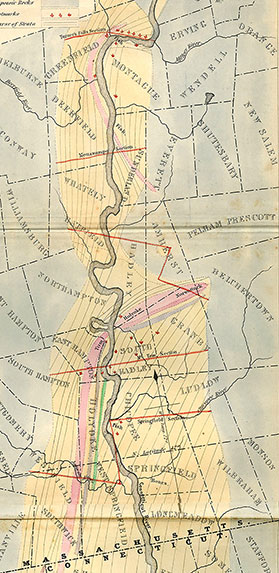Impressions from a Lost World: The Discovery of Dinosaur Footprints
Hitchcock's 1857 Ichnogeological Map

This map of the geology of the Connecticut River Valley was created by Edward Hitchcock to document the sites where "fossil bird tracks," now known as fossilized dinosaur tracks, had been found in the valley. Many fossils from these sites are now on display at the Beneski Museum of Natural History on the Amherst College campus.
Hitchcock called it an ichnogeological map because it shows the valley's geology and its ichnofossil, or trace fossil, sites. The geology is simplified. The key at the top shows colors for Sandstone, Trap, Volcanic Grit, Liassic Limestone (with marls and clays), Encrinal Limestone (with crinoid fragments), and Hypozoic Rocks (having no fossils). Ichnology is represented by little red 3-toed footprints showing where the trace fossil tracks had been found. Light lines show the "course of strata," meaning the orientation of the sandstone strata in which the footprints are found.
The map appeared as a long fold-out in Hitchcock's major work on the topic of the footprints, Ichnology of New England, published in 1858, the result of over 20 years of original work studying fossil footprints. Because he wanted the map to fit into his book, he did not orient it with north at the top, because doing so would have required a wider page. Therefore, the overlay here is tilted slightly to align with the base map.
When he saw his first fossil footprint in 1835, the word dinosaur had not been invented, and it was decades before the link was made between the footprints and skeletal remains found elsewhere. Hitchcock died believing he had established that most of the footprints had been made by birds--and today, most paleontologists would agree with him that birds descended from certain types of dinosaurs.